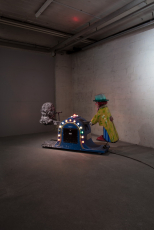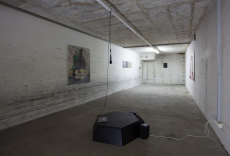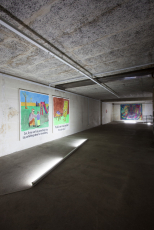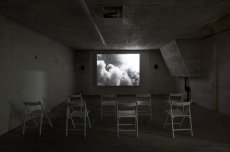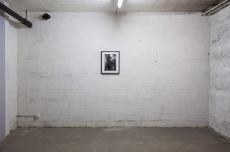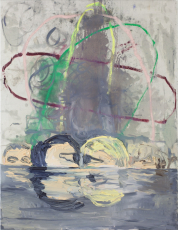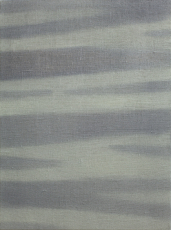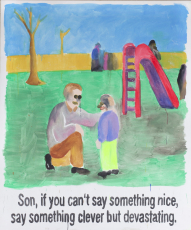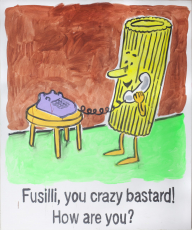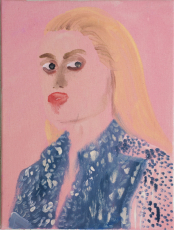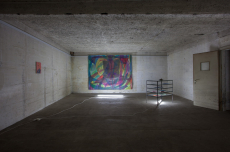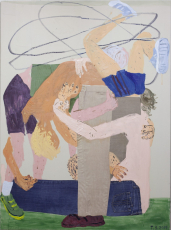Candy Colored Clown
Beni Bischof, Fritz Bornstück
Chad Burt, Jacob Dwyer
Sabine Schlatter, Gregor Schneider
28.08.–04.10.2014
Season opening Wednesday 27 August, 18–20 h
Basement Stationsstrasse 1, Entrance through the backyard
Filmscreening
Friday 26 September, 20 h / Opening and drinks at 19 h
Jacob Dwyer – The Squirrel (2012) 3.03 min.
Harmony Korine – Gummo (1997) 89 min.
Beni Bischof, Fritz Bornstück
Chad Burt, Jacob Dwyer
Sabine Schlatter, Gregor Schneider
Season opening Wednesday 27 August, 18–20 h
Basement Stationsstrasse 1, Entrance through the backyard
Filmscreening
Friday 26 September, 20 h / Opening and drinks at 19 h
Jacob Dwyer – The Squirrel (2012) 3.03 min.
Harmony Korine – Gummo (1997) 89 min.
Beni Bischof, Fritz Bornstück
Chad Burt, Jacob Dwyer
Sabine Schlatter, Gregor Schneider

«I learned that just beneath the surface there’s another world, and still different worlds as you dig deeper. I knew it as a kid, but I couldn't find the proof. It was just a feeling. There is a goodness in those blue skies and flowers, but another force — a wild pain and decay – also accompanies everything.» David Lynch
‹Candy Colored Clown› — The title of our season opening exhibition stands for the condition of uncertainty, and may be read as an allegory of the unconscious. Generally, the uncanny denotes inexplicable, partly scary phenomena that touch upon the unfamilar, indeed on all that arouses dread and creeping horror. So whereas the uncanny evokes fear on the one hand, it exerts a fascinating appeal on the other. The works assembled for ‹Candy Colored Clown› concern themselves with representations of reality and fiction, explore the alien within ourselves, ignore barriers, invite contradiction, and provoke deliberation on social norms and normalcies. Running through this body of work as crucial parameters are their artists’ underlying humour and a love for detail.
Occupying 300 square metres of sublevel architecture expanding beneath our gallery, ‹Candy Colored Clown› brings together various genres, ranging from contemporary grotesque over provocative, contemporary surrealism to installation and humour. This themed group exhibition rests on an aesthetics of effect and perception fuelled by the tension between the visible and the concealed, the mysterious lying behind what meets the eye. The ideas and concepts presented in ‹Candy Colored Clown› harbour a hidden secret, which may emerge at any time from the invisible to unsettle sheltered domesticity in the shape of the uncanny or the extraordinary.
In his 1919 essay The Uncanny, Freud described the uncanny as «that class of the terrifying which leads back to something long known to us, once very familiar», and as that which feeds on «the repeatedly repressed». Freud reached this conclusion following his etymological analysis of the German word unheimlich (literally, the ‹unhomely›, as he added in a footnote), in which he sought to shed light on the relation between the the signifier and the signified: thus, the homely (heimlich, heimisch), which is at first ‹familiar,› ‹belongs to the home,› and is ‹hidden› from the world outside, can become the uncanny — namely, when it is meant to remain ‹secret› and to be ‹kept from sight›, only to suddenly burst into the province of life from its concealment. As Freud observes, ‹Unheimlich is in some way or other a sub-species of heimlich.›
Beni Bischof, born in St. Gallen (Switzerland) in 1976. Selected exhibitions: Kunst Halle Sankt Gallen, Fotomuseum Winterthur, Helmhaus Zürich, Museum Marta Herford, The Fourth Moscow Biennale of Contemporary Art, Kunstraum Düsseldorf, CAPC Museum of Contemporary Art Bordeaux. He lives and works in St. Gallen and Widnau.
Fritz Bornstück, born in Weilburg (Germany) in 1982. Until the summer of 2012, he further developed his work during a two-year residency at De Ateliers (Amsterdam). He graduated from Thomas Zipp's master class at Berlin University of the Arts with a BA in Fine Arts in 2009. He lives and works in Berlin.
Chad Burt, born in Digby (Nova Scotia, Canada) in 1978. He studied visual art at Mount Allison University (New Brunswick) and holds an MA in Fine Arts from Goldsmiths, University of London. He was artist-in-residence at De Ateliers in Amsterdam from 2011 to 2013. He lives and works in Amsterdam.
Jacob Dwyer, born in London in 1988, studied fine art at Newcastle University. He holds an MA in Experimental Film from Kingston University, London. He has spent the last two years as an artist-in-residence at De Ateliers, Amsterdam. He lives and works in Amsterdam.
Sabine Schlatter, born in Zurich (Switzerland) in 1977. She studied Fine Arts at Zurich University of the Arts and was awarded a two-year artist-in-residency (2009–2011) by The Binz39 Foundation. From 2008 to 2010, she was a member of the artist collective ‹eggerschlatter›, which had several exhibitions and received various grants. She lives and works in Zurich.
Gregor Schneider, born in Rheydt (Germany) in 1969. He studied at Düsseldorf and Münster art academies from 1989 to 1992. In the late 1980s, Schneider began converting his home into what he called the Haus u r (the u r house). Today he is one of Germany’s best known visual artists. His magnum opus, ‹Totes Haus u r› (Dead House u r), for which he received the Golden Lion at the 2001 Venice Biennale, is one of the most important contemporary works of spatial art. He lives and works in Mönchengladbach-Rheydt.
For enquiries and image permissions, please contact the gallery office.
Kindly supported by Kyburz & Peck — English Language Projects, Galerie Mikael Andersen (Copenhagen), and Galerie Konrad Fischer (Düsseldorf).
‹Candy Colored Clown› — The title of our season opening exhibition stands for the condition of uncertainty, and may be read as an allegory of the unconscious. Generally, the uncanny denotes inexplicable, partly scary phenomena that touch upon the unfamilar, indeed on all that arouses dread and creeping horror. So whereas the uncanny evokes fear on the one hand, it exerts a fascinating appeal on the other. The works assembled for ‹Candy Colored Clown› concern themselves with representations of reality and fiction, explore the alien within ourselves, ignore barriers, invite contradiction, and provoke deliberation on social norms and normalcies. Running through this body of work as crucial parameters are their artists’ underlying humour and a love for detail.
Occupying 300 square metres of sublevel architecture expanding beneath our gallery, ‹Candy Colored Clown› brings together various genres, ranging from contemporary grotesque over provocative, contemporary surrealism to installation and humour. This themed group exhibition rests on an aesthetics of effect and perception fuelled by the tension between the visible and the concealed, the mysterious lying behind what meets the eye. The ideas and concepts presented in ‹Candy Colored Clown› harbour a hidden secret, which may emerge at any time from the invisible to unsettle sheltered domesticity in the shape of the uncanny or the extraordinary.
In his 1919 essay The Uncanny, Freud described the uncanny as «that class of the terrifying which leads back to something long known to us, once very familiar», and as that which feeds on «the repeatedly repressed». Freud reached this conclusion following his etymological analysis of the German word unheimlich (literally, the ‹unhomely›, as he added in a footnote), in which he sought to shed light on the relation between the the signifier and the signified: thus, the homely (heimlich, heimisch), which is at first ‹familiar,› ‹belongs to the home,› and is ‹hidden› from the world outside, can become the uncanny — namely, when it is meant to remain ‹secret› and to be ‹kept from sight›, only to suddenly burst into the province of life from its concealment. As Freud observes, ‹Unheimlich is in some way or other a sub-species of heimlich.›
Beni Bischof, born in St. Gallen (Switzerland) in 1976. Selected exhibitions: Kunst Halle Sankt Gallen, Fotomuseum Winterthur, Helmhaus Zürich, Museum Marta Herford, The Fourth Moscow Biennale of Contemporary Art, Kunstraum Düsseldorf, CAPC Museum of Contemporary Art Bordeaux. He lives and works in St. Gallen and Widnau.
Fritz Bornstück, born in Weilburg (Germany) in 1982. Until the summer of 2012, he further developed his work during a two-year residency at De Ateliers (Amsterdam). He graduated from Thomas Zipp's master class at Berlin University of the Arts with a BA in Fine Arts in 2009. He lives and works in Berlin.
Chad Burt, born in Digby (Nova Scotia, Canada) in 1978. He studied visual art at Mount Allison University (New Brunswick) and holds an MA in Fine Arts from Goldsmiths, University of London. He was artist-in-residence at De Ateliers in Amsterdam from 2011 to 2013. He lives and works in Amsterdam.
Jacob Dwyer, born in London in 1988, studied fine art at Newcastle University. He holds an MA in Experimental Film from Kingston University, London. He has spent the last two years as an artist-in-residence at De Ateliers, Amsterdam. He lives and works in Amsterdam.
Sabine Schlatter, born in Zurich (Switzerland) in 1977. She studied Fine Arts at Zurich University of the Arts and was awarded a two-year artist-in-residency (2009–2011) by The Binz39 Foundation. From 2008 to 2010, she was a member of the artist collective ‹eggerschlatter›, which had several exhibitions and received various grants. She lives and works in Zurich.
Gregor Schneider, born in Rheydt (Germany) in 1969. He studied at Düsseldorf and Münster art academies from 1989 to 1992. In the late 1980s, Schneider began converting his home into what he called the Haus u r (the u r house). Today he is one of Germany’s best known visual artists. His magnum opus, ‹Totes Haus u r› (Dead House u r), for which he received the Golden Lion at the 2001 Venice Biennale, is one of the most important contemporary works of spatial art. He lives and works in Mönchengladbach-Rheydt.
For enquiries and image permissions, please contact the gallery office.
Kindly supported by Kyburz & Peck — English Language Projects, Galerie Mikael Andersen (Copenhagen), and Galerie Konrad Fischer (Düsseldorf).
«I learned that just beneath the surface there’s another world, and still different worlds as you dig deeper. I knew it as a kid, but I couldn't find the proof. It was just a feeling. There is a goodness in those blue skies and flowers, but another force — a wild pain and decay — also accompanies everything.» David Lynch
Candy Colored Clown – Der Titel steht stellvertretend für einen Zustand des Ungewissen, eine Allegorie des Unbewussten. Unheimlich bezeichnet gemeinhin unerklärliche, teils schaurige Phänomene, die das uns Unbekannte streifen. Provoziert es einerseits Angst, übt es andererseits eine faszinierende Anziehungskraft aus. Die gezeigten Arbeiten setzen sich mit Abbildungen von Wirklichkeit und Fiktion auseinander, behandeln das Fremde in uns selbst, ignorieren Barrieren, lassen Widersprüche zu oder provozieren Überlegungen zu gesellschaftlichen Normalitäten. Hintergründiger Humor und die Liebe zum Detail sind hierbei wichtige Parameter.
In den 300 m2 Sublevel-Architektur unter den Galerieräumen treffen Genres von Contemporary Grotesque über Provocative, Contemporary Surrealistic, Installation und Humor aufeinander. Die thematische Gruppenausstellung ‹Candy Colored Clown› basiert auf einer Wirkungs- und Wahrnehmungsästhetik, die sich aus dem Spannungverhältnis zwischen Sichtbarem und der Bedeutung des darunter Verborgenen, Geheimnisvollen zusammensetzt. Gezeigte Ideen und Konzepte beheimaten ein verstecktes Geheimnis, das jederzeit aus dem Unsichtbaren hervortreten kann, um so die wohlbehütete Häuslichkeit in einen Zustand des Unbehagens oder Ausserordentlichen zu versetzen.
In seinem Aufsatz von 1919 bezeichnet Freud das Unheimliche als ‹jene Art des Schreckhaften, welche auf das Altbekannte, Längstvertraute zurückgeht› und sich aus dem ‹wiederkehrenden Verdrängten› speist. Zu diesem Schluss kommt Freud nach einer etymologischen Analyse des deutschen Wortes ‹unheimlich›, die versucht, die Beziehung zwischen Signifikantenstruktur und Signifikat zu klären: Das Heimliche, das zunächst das ‹Heimische›, das ‹zum Haus gehörige›, also auch das vor der Außenwelt ‹Versteckte› ist, kann zum Unheimlichen werden – nämlich dann, wenn das, was ‹ein Geheimnis› und ‹im Verborgenen bleiben sollte›, unerwartet hervortritt: ‹Unheimlich ist irgendwie eine Art von heimlich›.
Beni Bischof, 1976 in St. Gallen, Schweiz geboren, lebt und arbeitet in St. Gallen und Widnau, Schweiz. Seine Arbeiten waren unter anderem zu sehen in: Kunst Halle Sankt Gallen, Fotomuseum Winterthur, Helmhaus Zürich, Museum Marta Herford, The Fourth Moscow Biennale of Contemporary Art, Kunstraum Düsseldorf, CAPC Museum of Contemporary Art Bordeaux.
Fritz Bornstück, 1982 in Weilburg, Deutschland geboren, lebt und arbeitet in Berlin. Bis zum Sommer 2012 entwickelte er sein Oeuvre im Rahmen des zweijährigen De Ateliers Aufenthalts (Amsterdam, NL). 2009 absolvierte er seinen BA in Fine Arts an der Universität der Künste in Berlin als Meisterschüler von Thomas Zipp.
Chad Burt, 1978 in Digby, Nova Scotia, Kanada geboren, lebt und arbeitet in Amsterdam, Niederlande. Er studierte Bildende Kunst an der Mount Allison University in New Brunswick, Kanada und absolvierte den MA in Fine Arts am Goldsmiths, University of London. Von 2011–13 war er Teil des Residency Progamms am De Ateliers in Amsterdam.
Jacob Dwyer, 1988 in London, UK geboren, lebt und arbeitet in Amsterdam. Er studierte Bildende Kunst an der Newcastle University und absolvierte den MA in Experimentalfilm an der Kingston Universität, London. Die letzten 2 Jahre war er Teil des Residency Programms am De Ateliers in Amsterdam.
Sabine Schlatter, 1977 in Zürich geboren, lebt und arbeitet in Zürich. Von 2009 bis 2011 residierte sie mit einem Atelierstipendium der Stiftung Binz39. Sie studierte Bildende Kunst an der Zürcher Hochschule der Künste. Zwischen 2008 und 2010 war sie Teil des Künstlerkollektivs ‹eggerschlatter› mit zahlreichen Ausstellungen und Stipendien.
Gregor Schneider, 1969 in Rheydt, Deutschland geboren, lebt und arbeitet in Mönchengladbach, Rheydt, Deutschland. Von 1989 bis 1992 studierte er an den Kunstakademien Düsseldorf und Münster. Ende der 80er Jahre begann Schneider mit dem Umbau seines Wohnhauses, dem Haus ur. Gregor Schneider zählt heute zu den bekanntesten bildenden Künstlern Deutschlands. Sein Hauptwerk ‹Totes Haus u r› für das er 2001 mit dem Goldenen Löwen der Venedig-Biennale ausgezeichnet worden ist, zählt zu den wichtigsten Raumkunstwerken der Gegenwart.
Für Fragen und Bilder wenden Sie sich bitte an die Galerie.
Mit freundlicher Unterstützung von Kyburz & Peck — English Language Projects, Galerie Mikael Andersen, Copenhagen und Galerie Konrad Fischer, Düsseldorf.
Candy Colored Clown – Der Titel steht stellvertretend für einen Zustand des Ungewissen, eine Allegorie des Unbewussten. Unheimlich bezeichnet gemeinhin unerklärliche, teils schaurige Phänomene, die das uns Unbekannte streifen. Provoziert es einerseits Angst, übt es andererseits eine faszinierende Anziehungskraft aus. Die gezeigten Arbeiten setzen sich mit Abbildungen von Wirklichkeit und Fiktion auseinander, behandeln das Fremde in uns selbst, ignorieren Barrieren, lassen Widersprüche zu oder provozieren Überlegungen zu gesellschaftlichen Normalitäten. Hintergründiger Humor und die Liebe zum Detail sind hierbei wichtige Parameter.
In den 300 m2 Sublevel-Architektur unter den Galerieräumen treffen Genres von Contemporary Grotesque über Provocative, Contemporary Surrealistic, Installation und Humor aufeinander. Die thematische Gruppenausstellung ‹Candy Colored Clown› basiert auf einer Wirkungs- und Wahrnehmungsästhetik, die sich aus dem Spannungverhältnis zwischen Sichtbarem und der Bedeutung des darunter Verborgenen, Geheimnisvollen zusammensetzt. Gezeigte Ideen und Konzepte beheimaten ein verstecktes Geheimnis, das jederzeit aus dem Unsichtbaren hervortreten kann, um so die wohlbehütete Häuslichkeit in einen Zustand des Unbehagens oder Ausserordentlichen zu versetzen.
In seinem Aufsatz von 1919 bezeichnet Freud das Unheimliche als ‹jene Art des Schreckhaften, welche auf das Altbekannte, Längstvertraute zurückgeht› und sich aus dem ‹wiederkehrenden Verdrängten› speist. Zu diesem Schluss kommt Freud nach einer etymologischen Analyse des deutschen Wortes ‹unheimlich›, die versucht, die Beziehung zwischen Signifikantenstruktur und Signifikat zu klären: Das Heimliche, das zunächst das ‹Heimische›, das ‹zum Haus gehörige›, also auch das vor der Außenwelt ‹Versteckte› ist, kann zum Unheimlichen werden – nämlich dann, wenn das, was ‹ein Geheimnis› und ‹im Verborgenen bleiben sollte›, unerwartet hervortritt: ‹Unheimlich ist irgendwie eine Art von heimlich›.
Beni Bischof, 1976 in St. Gallen, Schweiz geboren, lebt und arbeitet in St. Gallen und Widnau, Schweiz. Seine Arbeiten waren unter anderem zu sehen in: Kunst Halle Sankt Gallen, Fotomuseum Winterthur, Helmhaus Zürich, Museum Marta Herford, The Fourth Moscow Biennale of Contemporary Art, Kunstraum Düsseldorf, CAPC Museum of Contemporary Art Bordeaux.
Fritz Bornstück, 1982 in Weilburg, Deutschland geboren, lebt und arbeitet in Berlin. Bis zum Sommer 2012 entwickelte er sein Oeuvre im Rahmen des zweijährigen De Ateliers Aufenthalts (Amsterdam, NL). 2009 absolvierte er seinen BA in Fine Arts an der Universität der Künste in Berlin als Meisterschüler von Thomas Zipp.
Chad Burt, 1978 in Digby, Nova Scotia, Kanada geboren, lebt und arbeitet in Amsterdam, Niederlande. Er studierte Bildende Kunst an der Mount Allison University in New Brunswick, Kanada und absolvierte den MA in Fine Arts am Goldsmiths, University of London. Von 2011–13 war er Teil des Residency Progamms am De Ateliers in Amsterdam.
Jacob Dwyer, 1988 in London, UK geboren, lebt und arbeitet in Amsterdam. Er studierte Bildende Kunst an der Newcastle University und absolvierte den MA in Experimentalfilm an der Kingston Universität, London. Die letzten 2 Jahre war er Teil des Residency Programms am De Ateliers in Amsterdam.
Sabine Schlatter, 1977 in Zürich geboren, lebt und arbeitet in Zürich. Von 2009 bis 2011 residierte sie mit einem Atelierstipendium der Stiftung Binz39. Sie studierte Bildende Kunst an der Zürcher Hochschule der Künste. Zwischen 2008 und 2010 war sie Teil des Künstlerkollektivs ‹eggerschlatter› mit zahlreichen Ausstellungen und Stipendien.
Gregor Schneider, 1969 in Rheydt, Deutschland geboren, lebt und arbeitet in Mönchengladbach, Rheydt, Deutschland. Von 1989 bis 1992 studierte er an den Kunstakademien Düsseldorf und Münster. Ende der 80er Jahre begann Schneider mit dem Umbau seines Wohnhauses, dem Haus ur. Gregor Schneider zählt heute zu den bekanntesten bildenden Künstlern Deutschlands. Sein Hauptwerk ‹Totes Haus u r› für das er 2001 mit dem Goldenen Löwen der Venedig-Biennale ausgezeichnet worden ist, zählt zu den wichtigsten Raumkunstwerken der Gegenwart.
Für Fragen und Bilder wenden Sie sich bitte an die Galerie.
Mit freundlicher Unterstützung von Kyburz & Peck — English Language Projects, Galerie Mikael Andersen, Copenhagen und Galerie Konrad Fischer, Düsseldorf.

